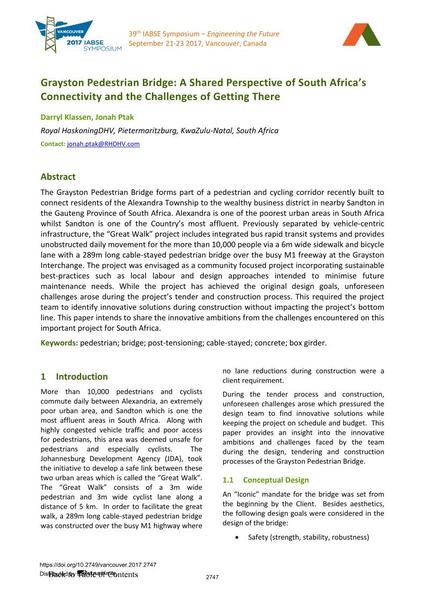Grayston Pedestrian Bridge: A Shared Perspective of South Africa’s Connectivity and the Challenges of Getting There

|
|
|||||||||||
Bibliografische Angaben
| Autor(en): |
Darryl Klassen
(Royal HaskoningDHV, Pietermaritzburg, KwaZulu-Natal, South Africa)
Jonah Ptak (Royal HaskoningDHV, Pietermaritzburg, KwaZulu-Natal, South Africa) |
||||
|---|---|---|---|---|---|
| Medium: | Tagungsbeitrag | ||||
| Sprache(n): | Englisch | ||||
| Tagung: | IABSE Symposium: Engineering the Future, Vancouver, Canada, 21-23 September 2017 | ||||
| Veröffentlicht in: | IABSE Symposium Vancouver 2017 | ||||
|
|||||
| Seite(n): | 2747-2754 | ||||
| Anzahl der Seiten (im PDF): | 8 | ||||
| Jahr: | 2017 | ||||
| DOI: | 10.2749/vancouver.2017.2747 | ||||
| Abstrakt: |
The Grayston Pedestrian Bridge forms part of a pedestrian and cycling corridor recently built to connect residents of the Alexandra Township to the wealthy business district in nearby Sandton in the Gauteng Province of South Africa. Alexandra is one of the poorest urban areas in South Africa whilst Sandton is one of the Country’s most affluent. Previously separated by vehicle-centric infrastructure, the “Great Walk” project includes integrated bus rapid transit systems and provides unobstructed daily movement for the more than 10,000 people via a 6m wide sidewalk and bicycle lane with a 289m long cable-stayed pedestrian bridge over the busy M1 freeway at the Grayston Interchange. The project was envisaged as a community focused project incorporating sustainable best-practices such as local labour and design approaches intended to minimise future maintenance needs. While the project has achieved the original design goals, unforeseen challenges arose during the project’s tender and construction process. This required the project team to identify innovative solutions during construction without impacting the project’s bottom line. This paper intends to share the innovative ambitions from the challenges encountered on this important project for South Africa. |
||||
| Stichwörter: |
Beton Brücke Hohlkasten
|
||||
